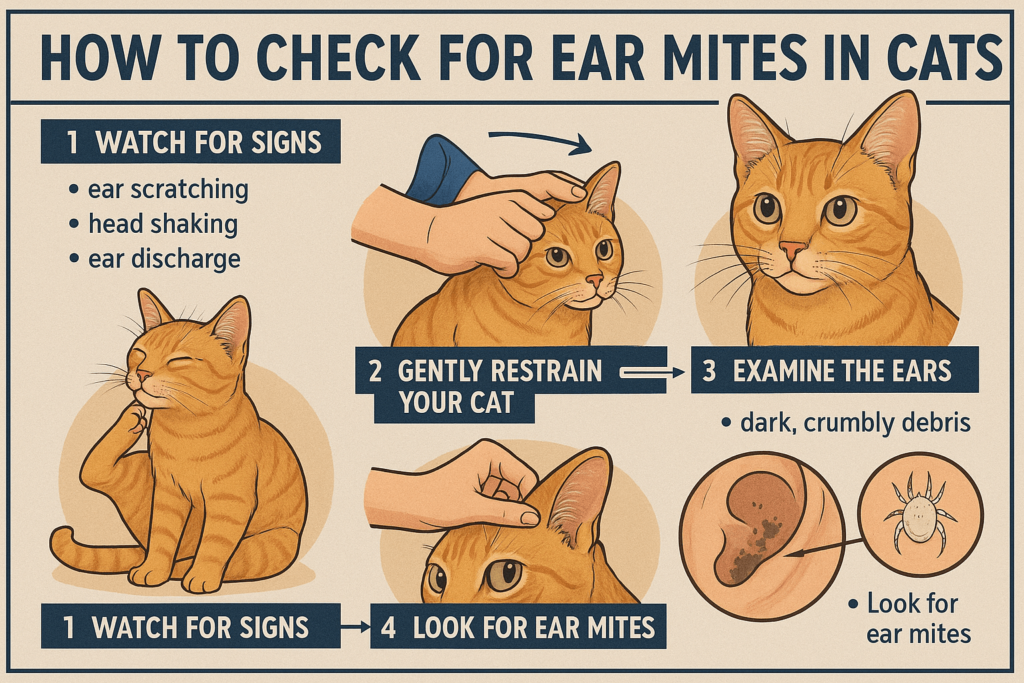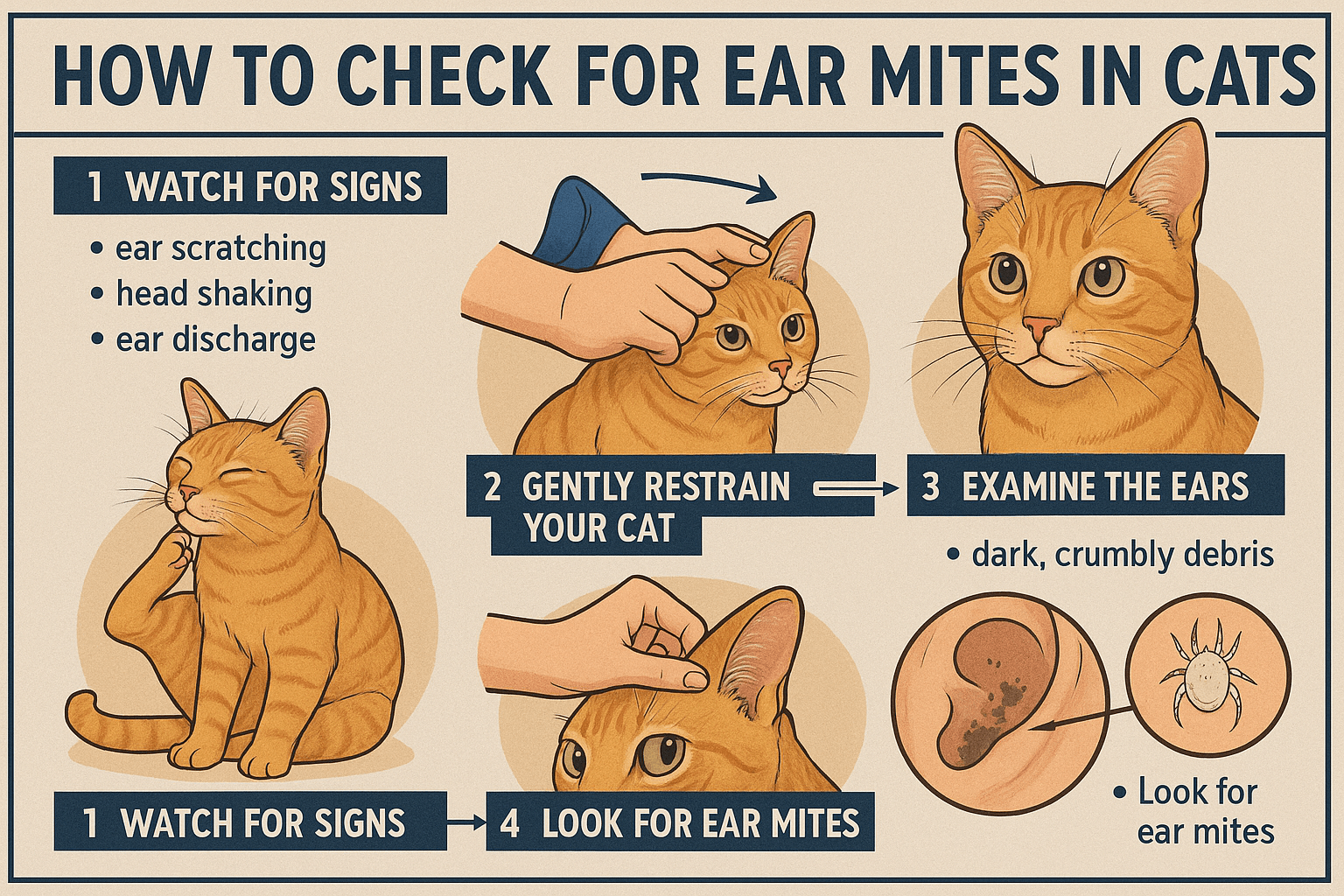How to Check for Ear Mites in Cats
Ear mites are tiny parasites that can cause significant discomfort for your feline friend. These pesky critters thrive in the warm, dark environment of a cat’s ear canal, leading to itching, irritation, and even secondary infections if left untreated. As a responsible cat owner, it’s crucial to recognize the signs of ear mites early and know how to check for them. This guide will walk you through everything you need to know about identifying, diagnosing, and addressing ear mites in cats—ensuring your furry companion stays happy, healthy, and itch-free.
Signs Your Cat May Have Ear Mites
Detecting ear mites starts with observing your cat’s behavior and physical symptoms. If you notice any of these common signs, it may be time to investigate further.
Excessive Scratching or Head Shaking:
Cats with ear mites often scratch their ears vigorously or shake their heads in an attempt to relieve irritation.Dark, Coffee-Ground-Like Debris:
Look inside your cat’s ears for dark, crumbly discharge that resembles coffee grounds—a telltale sign of ear mites.Redness or Inflammation:
The skin inside or around the ears may appear red, swollen, or irritated due to constant scratching.Unpleasant Odor:
A foul smell emanating from your cat’s ears can indicate an infestation or secondary infection caused by ear mites.Hair Loss Around the Ears:
Excessive scratching may lead to hair loss or bald patches near the ears and neck area.
If you observe these symptoms, it’s essential to act quickly to confirm the presence of ear mites and begin treatment promptly.

How to Check Your Cat’s Ears for Ear Mites
Checking your cat’s ears for ear mites is a straightforward process, but it requires patience and care. Follow these steps to examine your cat thoroughly and safely.
Gather Necessary Supplies:
Before starting, gather a flashlight, cotton balls, and a magnifying glass to help you see clearly inside your cat’s ears.Calm Your Cat Down:
Ensure your cat is relaxed before inspecting their ears. Use gentle petting or treats to create a positive atmosphere.Examine the Outer Ear:
Check for visible signs of irritation, swelling, or debris on the outer ear flap and surrounding areas.Look Inside the Ear Canal:
Gently fold back the ear flap and use a flashlight to illuminate the ear canal. Look for dark debris or movement indicative of mites.Avoid Probing Too Deeply:
Never insert anything into the ear canal, as this could harm your cat or push debris further inside.
By following these steps, you can effectively assess your cat’s ears and determine whether ear mites are present.
Check this guide 👉Cat Ear Mites Treatment: Best 7 Expert Tips!
Check this guide 👉Cat Ear Mites vs Wax: Best 7 Expert Tips!
Check this guide 👉How Do Indoor Cats Get Ear Mites? Best 7 Expert Tips!
Symptoms of Ear Mites in Cats | Steps to Prevent Ear Mites |
|---|---|
Excessive scratching or head shaking | Regularly clean your cat’s ears |
Dark, crumbly discharge | Keep your cat’s bedding clean |
Redness and inflammation | Avoid contact with infected animals |
Foul odor from the ears | Schedule routine vet check-ups |
Hair loss around the ears | Monitor outdoor cats closely |
How to Clean Your Cat’s Ears Safely
Cleaning your cat’s ears is an important step in managing ear mites and maintaining overall ear health. Follow these guidelines to ensure the process is safe and effective.
Use a Vet-Recommended Cleaner:
Choose a cleaning solution specifically designed for cats to avoid irritation or damage to the ear canal.Soak a Cotton Ball:
Dampen a cotton ball with the cleaning solution and gently wipe away visible debris from the outer ear.Massage the Base of the Ear:
After applying the cleaner, massage the base of the ear to loosen trapped dirt and mites. Allow your cat to shake out excess fluid.Avoid Q-Tips or Sharp Objects:
Never use Q-tips or other sharp tools, as they can injure your cat or push debris deeper into the ear.Reward Your Cat Afterward:
Offer treats or praise to reinforce positive associations with ear cleaning.
Proper cleaning not only helps remove ear mites but also prevents future infestations and complications.
Treatment Options for Ear Mites in Cats
Once ear mites are confirmed, prompt treatment is essential to eliminate the infestation and prevent recurrence. Here are some common treatment options available for your cat.
Topical Medications:
Prescription ear drops or topical treatments applied to the back of the neck can effectively kill ear mites.Oral Medications:
In some cases, oral medications may be prescribed to address severe infestations or secondary infections.Over-the-Counter Solutions:
Mild cases may respond to over-the-counter ear cleaners, though vet-recommended products are typically more effective.Environmental Cleaning:
Wash your cat’s bedding, toys, and grooming tools to eliminate any lingering mites and prevent reinfestation.Follow-Up Vet Visits:
Schedule follow-up appointments with your veterinarian to ensure the infestation has been fully eradicated.
With consistent treatment and care, ear mites can be successfully eliminated, restoring your cat’s comfort and health.
Preventative Measures to Avoid Ear Mite Infestations
Prevention is always better than cure when it comes to ear mites. Implementing these strategies can significantly reduce the risk of infestation for your cat.
Schedule Regular Vet Check-Ups:
Routine veterinary visits allow early detection of potential ear issues before they escalate.Keep Your Home Clean:
Vacuum carpets, wash bedding, and disinfect surfaces regularly to minimize the risk of parasite spread.Limit Exposure to Stray Animals:
Stray cats and dogs are common carriers of ear mites; keeping your pet indoors reduces exposure.Inspect New Pets Before Introducing Them:
If adopting a new pet, have them checked for ear mites and other parasites before bringing them home.Maintain Good Hygiene Practices:
Regular grooming and ear cleaning help keep your cat’s ears in optimal condition.
By taking these proactive steps, you can safeguard your cat against ear mites and promote long-term ear health.
Common Misconceptions About Ear Mites
Misunderstandings about ear mites can lead to improper treatment or delayed care. Clearing up these misconceptions ensures you approach the issue correctly.
Myth: Ear Mites Only Affect Outdoor Cats:
Indoor cats can also contract ear mites through contact with infected pets or contaminated objects.Myth: All Ear Problems Are Caused by Ear Mites:
Other conditions like bacterial infections or allergies can mimic ear mite symptoms, requiring accurate diagnosis.Myth: Over-the-Counter Treatments Always Work:
Some infestations require prescription-strength medications for complete resolution.Myth: Ear Mites Are Harmless:
Left untreated, ear mites can cause painful infections and permanent damage to your cat’s ears.Myth: One Treatment Is Enough:
Multiple treatments over several weeks are often necessary to fully eradicate ear mites.
Understanding these truths ensures you address ear mites appropriately and seek professional guidance when needed.
How to Comfort a Cat with Ear Mites
Cats suffering from ear mites may feel anxious or uncomfortable. Providing comfort during treatment can ease their distress and strengthen your bond.
Offer Soft Bedding:
Provide plush, clean bedding to cushion their ears and encourage restful sleep.Minimize Stressful Situations:
Reduce loud noises or sudden changes in routine to help your cat relax while recovering.Apply Warm Compresses:
Gently apply a warm, damp cloth to the outer ear to soothe irritation (avoid inserting anything into the ear canal).Engage in Gentle Playtime:
Light play sessions distract your cat from discomfort and boost their mood.Administer Treats and Affection:
Reward your cat with extra love and treats to reassure them during this challenging time.
By prioritizing your cat’s comfort, you can make the recovery process smoother and more enjoyable for them.
Frequently Asked Questions About Ear Mites in Cats
Can humans get ear mites from cats?
While rare, humans can develop skin irritation from ear mites but cannot host them long-term.
How long does it take to treat ear mites?
Treatment typically lasts 2-4 weeks, depending on the severity of the infestation.
Are ear mites contagious to other pets?
Yes, ear mites are highly contagious and can spread to other cats and dogs in the household.
What happens if ear mites go untreated?
Untreated ear mites can lead to severe ear infections, hearing damage, or chronic discomfort for your cat.
Can I use home remedies for ear mites?
Home remedies like olive oil may provide temporary relief but are not a substitute for professional treatment.
Keeping Your Cat’s Ears Healthy and Mite-Free
Ear mites can be a frustrating and uncomfortable problem for both cats and their owners, but with vigilance and proper care, they are entirely manageable. By learning how to check for ear mites, clean your cat’s ears safely, and administer treatment effectively, you can protect your feline friend from unnecessary suffering. Regular monitoring and preventative measures will ensure your cat’s ears remain healthy and free from these pesky parasites. Remember, a little effort goes a long way in keeping your furry companion happy and comfortable!
Understanding Cryptosporidium in Cats: Best 7 Expert Tips! – Spot symptoms, treat safely, and stop parasite spread in your home.
Understanding Cryptosporidium in Dogs: Best 7 Expert Tips! – Learn symptoms, treatment & prevention for this stubborn gut parasite.
Understanding Syringomyelia in Cats: Best 7 Expert Tips! – Recognize signs, manage pain, and support your cat’s neurological health with vet-backed guidance.
Understanding Syringomyelia in Dogs: Best 7 Expert Tips! – Expert insights on symptoms, MRI diagnosis, pain management & quality of life.





